

August is the doldrums of our humid Southern summers. Yet . . . September is only four weeks away and it marks the beginning of glorious, uplifting Tall Fescue Time.
If you're eager for Tall Fescue Time, you can prep by measuring your lawn to determine how much Tall Fescue seed or sod to order to refresh it for the cool months ahead.
Continue to hold the line by avoiding high-nitrogen fertilizer and skip overseeding until it gets cool out in September. To help your Tall Fescue do its best right now, we recommend fungicide to prevent brown patch.
Order fungicide online for direct shipment or local pick up. Or let us plan ahead for you . . . sign up for Lawn Coach "Champ" and we'll stick it in the mail at the right time.
>> Read about the importance of fungicide for Tall Fescue during warm months 
How to Care for Your Lawn When it's Hot
In the Southeast, we are currently entering a rainy week with mild temperatures. However, it's still summer, so don't put away your hoses and sprinklers just yet, as warm, dry conditions will probably return at least one more time before cool weather arrives.
If (when) it does get hot and dry again, keep an eye out for heat stress in your lawn. Heat stress can cause grass to change color - not just brown, but sometimes a grey-blue color. If you noticed bluish patches in your lawn, turn on your irrigation right away!
Read our tips on how to care for your lawn when it's hot >>
How to Water Your Tall Fescue Lawn
💧 Tall Fescue lawns like 2" of water a week during summer. That's up from 1" a week during the cool months.
Water your lawn in the morning: Why the fuss? Water sitting around on leaves promotes diseases. When you water in the morning, moisture rapidly dries from the leaf blades when the sun is out. If you water in the evenings, moisture may not evaporate from the leaves until the next day. Watering in the evenings promotes diseases.
Fall Armyworm Alert
Fall Armyworms love, love, and I mean LOVE Tall Fescue Lawns. Besides the fact that they devour lawns, there are two annoying things about the name of this creature:
🐛 It's not a worm. It's a caterpillar.
🐛 They are called "fall" armyworms. It's not fall yet, it's the doldrums of summer, but this caterpillar doesn't know that "fall" (or worms) is in their name, so you could see them any day now until frost.
Since Tall Fescue lawns are food of choice for fall armyworms, we recommend preventative insecticide for both new and established Tall Fescue lawns.
If areas of your lawn look mysteriously brown and chewed on, it might be these caterpillars. >>Read up on fall armyworms

Insecticide & Fertilizer Tips
- 🐛 Fall armyworms are a pervasive insect threat from July to first frost in autumn. We recommend our 5-10-30 + Acelepryn insecticide for Tall Fescue lawns. Order 5-10-30 + Acelepryn for pick up or delivery or check out our Lawn Coach subscription.
👍 It's safely low in nitrogen and the phosphorus and potassium will benefit overall health. - 🐛 These fall armyworms adore tender, new sod that has recently been installed. Fescue is especially vulnerable because it's not a spreader and doesn't have the ability to repair itself like Bermuda and Zoysia does. If you've recently laid Tall Fescue sod, we highly recommend spreading 5-10-30 + Acelepryn as insurance. It lasts 30-45 days, depending on weather conditions, so keep in mind that you may need to reapply it once more this summer.
- 🚫 Don't fertilize with high nitrogen until it's cool out in September! Because your Tall Fescue lawn will have slow growth during August, it does not need much nitrogen (5-10-30 is low in nitrogen and is safe). Seriously, high nitrogen is a waste of money at this time and it will augment problems such as brown patch.
- 👍 Real World Example: Don't use 16-4-8 fertilizers when it's hot. The 16 represents the amount of nitrogen. It's okay to use a low nitrogen fertilizer such as 5-10-30. We know you love to apply products, so we want to take another chance to steer you toward applying fungicide instead of any fertilizer through summer.
- Review the fertilizing schedule in our Tall Fescue Maintenance Guide.
- Sign up for Lawn Coach and we'll automatically mail you all the right fertilizers when you need them (including the fungicide when you select the Champ package).
- Even though it's not a good time to fertilize with nitrogen, it's still okay to apply fast-acting lime if you need to neutralize the pH of your soil. Always take a soil test to confirm if you need to apply lime or fertilizer. Balanced soil pH is critical for your grass to be able to use the nutrients supplied by your fertilizer.
Weeding Tips
- Pre-emergent herbicide: If you're not starting a new lawn from seed, the window for pre-emergent herbicide opens next month too! For weeds you see now, you can apply post-emergent liquid herbicides in established lawns. Read the label and follow instructions.
👍 Rule of Thumb #1: It's okay to apply a post-emergent liquid herbicide labeled for warm-season lawns after you've mowed your new lawn 3 to 4 times.
👍 Rule of Thumb #2: Don't apply pre-emergent if you plan on reseeding a Tall Fescue lawn. How come? The pre-emergent will also inhibit your Tall Fescue seeds from germinating. - Pulling by Hand: Tomorrow morning pour yourself a cuppa and pad around your garden looking for stray weeds. Pull up the biggest ones by hand. If you do a little every day, you'll see your progress.
- Mowing: Mow those weeds down before they go to seed. Mowing is an effective way to suppress weeds because it cuts off flower/seed heads and that stops weeds from making more weeds, thus breaking the life cycle. If you have bad weeds, mow on a weekly routine and don't let the weeds get ahead of you.
- Mulch suppresses weed seeds in flower beds. Spread your favorite mulch 2-4" thick and keep it 1-2" away from touching the trunks or stems of your plants.
- Because this weed is difficult to pull up by hand, I almost get goose bumps when I see it. Read how to get rid of it in your lawn and flower beds: August Weed of the Month: Goosegrass
I have to get a shovel and dig up goosegrass - large clumps are tenaciously rooted and I cannot pull them up by hand. The best control is mowing and pre-emergent herbicide.
Mowing Tips
Mowing Height: You should already be mowing at 3 to 4" height for the warm months; we'll remind you in the fall when it's time to lower the height back down to 2.5-3" for the cool months.
Mowing Frequency: During spring you were probably mowing on a once-a-week frequency (we recommend every 5 to 7 days when Tall Fescue is actively growing). During the hot days of summer, your Tall Fescue lawn will slow down, so you'll probably need to mow less frequently. You can keep on a weekly schedule to keep down any weed pressure you may experience, even though you may be mowing off very little of the Tall Fescue leaves.
Laying Sod & Planting Seed
To successfully plant Tall Fescue seed and sod, wait just one more month until September. We'll send an email letting you know it's time!
Prepare for overseeding Tall Fescue by cleaning up your lawn and spraying out weeds. This way, you'll have that task taken care of well before planting season and it won't be a last-minute problem to solve.
For tips on what to do for Warm Season lawns such as Bermuda, Centipede, Zoysia, peruse this page: August Warm Season Lawn Tips.
Got questions? Leave a comment below!
Come back next month for September's Lawn Tips for Tall Fescue lawns!
If you're new here, subscribe to our emails to get this information in your inbox every month.







